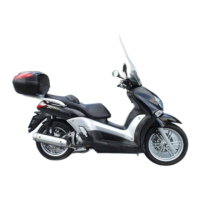
Do you have a question about the Yamaha XCITY VP250 and is the answer not in the manual?
| Displacement | 249cc |
|---|---|
| Fuel Capacity | 10.5 litres |
| Valves | 4 |
| Compression Ratio | 10.0 : 1 |
| Fuel System | Fuel Injection |
| Ignition System | TCI |
| Transmission System | V-Belt Automatic |
| Front Suspension | Telescopic fork |
| Rear Suspension | Unit Swing |
| Wheelbase | 1, 540 mm |
| Starter System | Electric |
| Engine Type | 4-stroke, SOHC |
| Transmission | Automatic |
| Weight | 173 kg (with oil and full fuel tank) |
| Engine | Single cylinder, 4-stroke, SOHC |
| Front Brake | Hydraulic single disc, 267 mm |
| Front Tyre | 120/70 |
| Rear Tyre | 140/70 |
| Front Tire Size | 120/70 |
Explains symbols like WARNING, NOTICE, and TIP for important information.
Details owner's responsibilities, safe riding techniques, and pre-operation checks.
Emphasizes protective gear and avoiding carbon monoxide poisoning hazards.
Provides guidelines for loading cargo and using genuine Yamaha accessories.
Warns about aftermarket parts and stresses proper tire/rim selection.
Offers additional advice for safe operation in various conditions.
Identifies key components on the left side of the scooter.
Identifies key components on the right side of the scooter.
Details the location and function of various controls and instruments.
Explains the main switch positions and how to lock the steering.
Describes the function of dashboard indicator and warning lights.
Explains the speedometer, fuel gauge, and fuel level warning light.
Details the coolant gauge and the multi-function display features.
Explains how to use odometer, tripmeter modes, and set the clock.
Describes ambient temperature display and oil change indicator reset.
Explains handlebar switches (dimmer, turn signal, horn) and start switch.
Details operation of brake levers and fuel tank cap.
Covers safe refueling and information on catalytic converters.
Instructions for accessing the seat and using storage compartments.
How to adjust windshield height and shock absorber spring preload.
Information on luggage hook, sidestand, and ignition circuit cut-off system.
Procedure to verify the proper function of the ignition circuit cut-off system.
Covers checks for fuel, engine oil, coolant, and brakes before riding.
Details checks for throttle grip, wheels, tires, brake levers, and chassis fasteners.
Ensures operation of lights, signals, switches, and sidestand switch.
Step-by-step guide to starting the engine, including precautions.
Procedures for moving off and controlling acceleration/deceleration.
Safe braking methods and tips to reduce fuel consumption.
Guidance on engine break-in period and safe parking practices.
Information on the tool kit and the periodic maintenance chart.
Instructions for accessing components by removing cowlings and panels.
Procedures for checking spark plug condition and engine oil level.
Step-by-step guide for changing the engine oil.
Procedures for checking final transmission oil and coolant levels.
Details on replacing air filters and checking throttle cable free play.
Information on tire pressure, inspection, and wheel bearing checks.
Procedures for checking brake pads, fluid levels, and changing brake fluid.
Lubricating control cables, brake levers, centerstand, and sidestand.
Checking front fork operation, steering bearings, and wheel bearings.
Information on battery care and replacing fuses.
Steps for replacing headlight, turn signal, and tail/brake light bulbs.
General troubleshooting guide for engine issues and performance problems.
Steps to diagnose and resolve engine overheating issues.
Instructions for cleaning the scooter to maintain appearance and function.
Guidelines for storing the scooter properly for different durations.
Technical specifications for the scooter's physical dimensions and weight.
Details on engine oil, fuel capacity, and spark plug specifications.
Specifications for frame, tires, wheels, and brake systems.
Details on suspension, electrical system, and battery specifications.
List of main, headlight, signaling, ignition, radiator fan, ECU, and backup fuses.
Importance and recording of key and vehicle identification numbers.
Details about the model label and its required information.